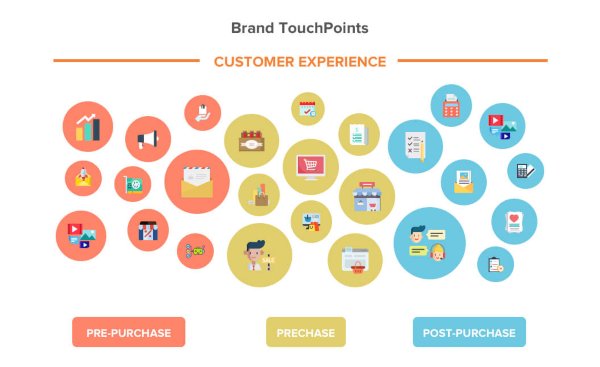The Customer Cycle: Generating Experiences and Touchpoints
The customer journey represents the phases a customer archetype passes through as they interact with the product or service under analysis. We have to distinguish the stages the Buyer Persona goes through, mapping out the experience a customer has before, during, and after being in contact with our product or service, usage context, motivations, goals, and even finding out how they’re feeling at all times.
Prospective consumers won’t seek out brands unless they need them. That’s when they’ll start researching the different options out there on the market and what can best satisfy their needs. Then, they’ll choose the product or service, and if all goes well, they’ll buy it. This complete customer life cycle is when we make our brand premise tangible. We’ll gain customers’ loyalty if it works for them. If we do it well, we’ll gain fans and recommendations.

The customer journey represents the phases a customer archetype passes through as they interact with the product or service under analysis. We have to distinguish the stages the Buyer Persona goes through, mapping out the experience a customer has before, during, and after being in contact with our product or service, usage context, motivations, goals, and even finding out how they’re feeling at all times.
Prospective consumers won’t seek out brands unless they need them. That’s when they’ll start researching the different options out there on the market and what can best satisfy their needs. Then, they’ll choose the product or service, and if all goes well, they’ll buy it. This complete customer life cycle is when we make our brand premise tangible. We’ll gain customers’ loyalty if it works for them. If we do it well, we’ll gain fans and recommendations.
Touchpoints: A fundamental aspect of the customer life cycle
Touchpoints in marketing are the channels a firm or customer can interact with each other. The examples of touchpoints in marketing can include brick-and-mortar stores, the Customer Service department, website, social media, calls-to-action (CTAs), etc. The result can be very straightforward or complicated as we need it to understand our customers and provide them value.
Our end-goal is that we want the information in the customer journey map for every Buyer Persona to help us in several ways. They’re what we offer, pinpoint potential mistakes or discrepancies in what we want to provide and what we provide in real life, or even find the best channel for communicating with our customers. Every interaction can create an experience and works towards fostering a relationship between brands and customers.
The sum of all these touchpoints and experiences work towards creating sentiment about the product or service and consumers’ attitudes and behaviours towards the brand. Touchpoints are some of the critical components of Customer Experience Management (CXM) since that’s the place where we foster the bond (experience) between the brand and the customer. Touchpoints go into a broader concept of the customer business life cycle where brands get hooked.
There are many moments that matter throughout the customer life cycle and they expect we’ll give them good experiences throughout the entire cycle. If we fail in something critical and don’t know how to figure it out, the customer will abandon us.
Three critical components to consider when creating touchpoints
It’s essential to consider three elements of the current market panorama and consumer behaviour when working on our customer life cycle marketing. They are:
-
Consumer behaviour is a critical component to consider when tracing the touchpoints and customer life cycle. You have to understand them correctly to get your actions right and ensure your strategies have the appropriate messaging and distribution channel to reach your customer.
-
Customers have superpowers. Customers give a more open, frequent opinion about their experiences with products and services, making taking care of the fundamental. Positive or negative sentiment can be critical and travel at the speed of light through social media and speciality forums. Kotler has attempted to illustrate this brand-customer relationship over decades in his books as he moved from Marketing 1.0 and Marketing 4.0.
-
Consumers increasingly recall brand messaging less due to an excess of information. While they paid attention to an average of 30 seconds of ads, the figure now ranges between seven and 15 seconds. The difference can lie in disseminating a clear, appealing message at the right time.
Due to these three fundamental factors in today’s consumer behaviour, marketing with micro-moments has proven critical for defining customer touchpoints. This Google ad perfectly summarizes why it has so much prominence now.
Access to information grants consumers the ability to evaluate options throughout the entire customer life cycle continuously. Search and analysis are intentional and sway decisions, whether they’re the moment and time. The relevance and quality of the information in those micro-moments modulates the purchase decision.
How to make a touchpoint map
1. Identify the touchpoints
Every organization must define the touchpoint map that best adapts to their customers and context. Before we can correctly set these touchpoints, we must:
-
Understand the customer’s life cycle well and have a strategy with definite goals in every stage. What do we want our customers to do, feel, and think in the most critical moments?
-
Be able to set clear objectives and metrics so the interactions, events, or situations arise or if they’re not working. Measuring different strategies and actions is vital!
 Source: Net Solutions
Source: Net Solutions
But what premises should we follow when identifying and defining our touchpoints?
The customer’s vision is different from that of the brand, so we can’t base ourselves merely on internal analyses or reproduce touchpoint maps that reflect our organizational structure.
Not all customers follow the same path in their relationship with us, nor do they have the same needs. That’s why we must understand the key differences between types of customers and distinguishing between touchpoints. How can we do it? We must identify and ensure the emotional components of our customers are in the touchpoint map. Our discussions of measuring and being objective also encompass the customer’s world of emotions.
We must also know what our competitors are doing and how we can stand out. We must also anticipate whether what we’re proposing is something our competitors can easily emulate. We must make adjustments over time as our definition of touchpoints, and the touchpoint map will differ depending on what our customers do, our business, and other factors that can impact them both.
2. Defining the elements and variables well
We must have our touchpoints in mind with a goal of garnering customer loyalty, or once they’ve bought our product or contracted our service.
The most effective representation of the touchpoint map is on a Cartesian axis. We represent the moments of our customer’s life cycle on one axis and the potential channels where they contact our brand on the other.
We can find different elements that serve as content on our touchpoint map:
-
Characteristics of the product or service: The product or service offering, attributes, and how customers perceive them.
-
Interactions: Any reciprocal interaction, whether in person, on the phone, online, etc. Most of these interactions are currently through the web, social media, or emails, making sure that we have to take special care of them.
-
Communication: Messages to the customer include the logo, brand, advertising, packaging, and invoice. In sum, it’s everything I’m communicating to customers through any possible medium.
-
Emotions and perceptions: Those feelings we’re creating in the customer result from our relationship with them. In this sense, the purchasing experience will make a crucial difference when creating a positive or negative sentiment for the customer.
The balance and homogeneity that we’re going to deliver in the various touchpoints are critical. We know that customers integrate experiences to form an opinion. These opinions are not static over time, as well as in every purchasing stage.
We must have our touchpoints in mind to garner customer loyalty, or once they’ve bought our product or contracted our service.
3. Creating a value proposition for the customer life cycle
The value proposition we create and end up transmitting is the reflection of our business strategy. We must decide what variables will be part of it:
-
Price? It could impact the early stages of the customer life cycle, and we’ll have to communicate a perhaps optimal quality/price ratio in our points of sale.
-
Service? The perception of added-value services during use is fundamental for products with little differentiation.
-
Personalization? The ability to accurately answer a broad range of customers’ needs is an influential differentiation factor in today’s market.
-
Closeness? Transmit trust and respect to the customer—personalized attention, perception of mutual benefit, and worrying about solving problems.
In summary, do touchpoints help improve the customer experience?
The touchpoint map is a vital component for managing our Customer Experience Management strategy. It will be our primary means of communication to the organization and where we’ll define our goals and metrics. We must design the Customer Experience and not leave it to chance by creating a touchpoint map.
We build this map on top of the customer journey stage in their relationship with the brand and our strategy. It must have coherence to be practical. The key lies in having a concrete value proposition.
Measuring and correlating our metrics with crucial business indicators helps complete these interactions and get the best out of each touchpoint.
Subscribe to our newsletter and stay up to date with the latest digital trends.
Subscribe to our newsletter and stay up to date with the latest digital trends.
No thanks. My inbox is fine as it is.